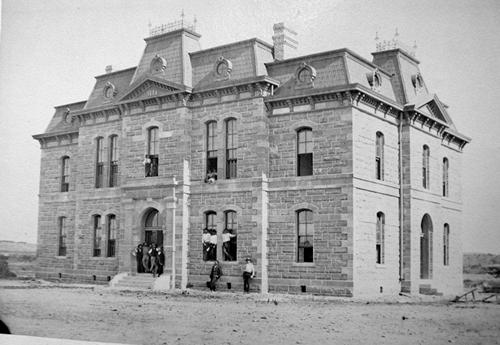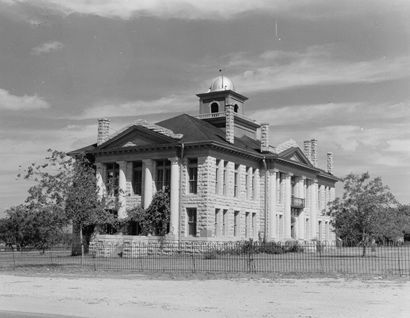Books by
Michael Barr
Order Here: |
|
|
Government
gridlock and political polarization did not begin in the 21st Century.
In the 1880s, and for years after,
Blanco County was aflame in partisan politics and divided government.
Angry citizens were split right down the middle over the location
of the courthouse.
On February 12, 1858 the legislature in Austin
formed a new Texas county from parts of Comal,
Hays, Burnet
and Gillespie
Counties. The legislation stated that the new county would be called
Blanco, after
the Blanco
River, and that an election would be held to determine the exact
location of the county seat.
In those days, before fast travel and modern forms of communication,
government officials went to great lengths to insure that the seat
of county government was centrally located so all citizens had equal
access to it. State law directed that the county seat had to be
within 5 miles of the geographic center of the county unless two
thirds of the voters voted otherwise. The general rule was that
the county seat was not more than a day's ride from anywhere in
the county.
In the new county of Blanco,
residents selected a beautiful spot on the north bank of the Blanco
River as the site for the new county seat. They called the new
town Blanco.
The site was near the geographic center and met all the requirements
of state law.
In 1860 county officials erected a simple courthouse in Blanco.
Then in 1885 voters approved the expenditure of $27,000 for a fancy
new limestone courthouse that still stands in the middle of the
public square.
|
 |
|
But Blanco
County was unable to settle in to the rhythm of everyday life.
As new counties formed around it, Blanco
County was carved up and pieced back together again at the whim
of the legislature in Austin.
In 1862 Blanco County
lost a large area of land when the legislature formed Kendall
County, but legislators compensated Blanco
County by giving it parts of Hays
and Burnet Counties.
The problem was that once the county borders were permanently established,
the town of Blanco,
the county seat, was no longer near the geographic center.
Meanwhile,
the Johnson brothers, Andrew, Sam and Tom, established a cattle
ranching operation to the north of Blanco,
in the central part of the county. With a talent for political scheming
and backroom bargaining - a talent inherited by Sam's grandson,
the one who became president of the United States - the Johnsons
and their neighbors established a new town on the banks of the Pedernales
River, strategically located near the center of Blanco
County. From the beginning Johnson
City had one major goal: to wrestle the seat of government from
its neighbors, 14 miles to the south.
It took 12 years, some bloodshed and a lot of hard feelings to get
it done.
In January 1890 the citizens of Blanco
County went to the polls to decide, once and for all, the location
of their county seat. The election did not go smoothly. There were
rumors of ballot-stuffing. The San Antonio Daily Light reported
details of an election-day gunfight between a Blanco
supporter and a Johnson
City advocate. One man was killed and a deputy sheriff was shot
in the leg. Lawmen quickly whisked the shooter away to the jail
just ahead of the lynch mob. But in the end the citizens of Blanco
County voted, by a margin of 65 votes, to move the county seat
from Blanco
to Johnson
City.
After county officials moved out, the old Blanco
County Courthouse became, at one time or another, an office
building, a school, a hospital, a town hall, a museum, a theater,
a library and a restaurant. For a time the Blanco National Bank
used the vaults in the old building once used by county tax collectors.
The current Blanco
County Courthouse, in Johnson
City not in Blanco,
was built in 1916.
|
 |
Sources:
Texas Local Government Code Chapter 73. Location of County Government.
"State News Condensed," San Antonio Daily Light, January 23, 1890.
"A Fatal Election Row in Blanco County," The Galveston Daily News,
January 23, 1890.
The Handbook of Texas, Blanco County. |
|
|
